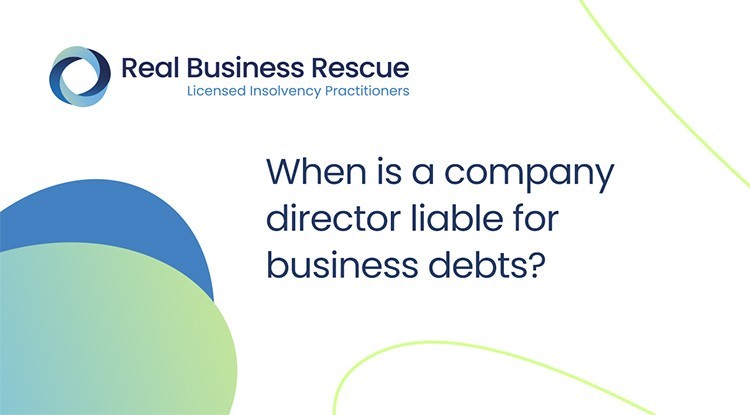
Understand your company's position and learn more about the options available
Require Immediate Support? Free Director Helpline: 0800 644 6080
Free Director Helpline: 0800 644 6080
Updated:
A company director can be held personally liable for the debts of their company in certain instances. Any debts belonging to the company which have been secured with a personal guarantee will need to be repaid by the director should the company become insolvent and subsequently enter liquidation. Directors can also be held liable for company debts should he or she be found guilty of misconduct or fraud.
Directors are not made personally liable for the debts of their limited company in the vast majority of situations.
This is because limited companies have the benefit of limited liability. Put simply, this means your personal responsibility for the debts of the business is limited to the amount of your investment within the company.
When incorporated as a limited company, your business will be seen as its own separate legal entity, something which can be extremely important should the company later run into financial difficulties and is forced to enter into liquidation.

Limited liability is a layer of protection which is placed between a limited company and its directors as individual. It ensures a director's personal liability is limited to the amount they have invested into the company. This means the directors cannot be held personally responsible for the debts of the limited company should it later become insolvent and unable to pay its debts.
Free 60 Second Test
For Ltd Company Directors
What are you looking to do?
Choose below:
In business terms, a liability often refers to a sum of money, contractual obligation, or other debt owed by a company. This could be a loan, hire purchase agreement, a commercial lease, or an unpaid invoice to a creditor.
A huge advantage of operating as a limited company rather than a sole trader is the protection offered by limited liability, particularly in instances when the company's financial position takes a turn for the worse.
As a limited company is seen as its own legal entity, any unsecured debt which remains outstanding following the company entering into a formal insolvency procedure such as a Creditors’ Voluntary Liquidation (CVL) will be written off. In simple terms, the debts of the company belong to the company.
Company directors are not held responsible for repaying any shortfall nor are creditors are allowed to demand the company director make payments from his or her own personal finances to pay back this money. Essentially the debts of the company are written off when you close a company in the vast majority of cases.
“Called for help with closing non-trading companies and Chelsea advised me on what to do and instead of taking advantage as others would by taking on the case and charging loads. She gave me a solution that would cost £20. Very pleased with the service and thankful for Chelsea’s advice.”
AB
While limited liability company status offers valuable protection to a director, there are certain situations where limited liability can be disregarded, leaving the director personally responsible and ultimately liable for repaying some or all the company’s debts.
Once a company becomes insolvent and enters into formal insolvency proceedings, the appointed insolvency practitioner has a duty to investigate the conduct of the directors during the time leading up to the company becoming insolvent.
During this investigation, they will be looking for any instances of misconduct or fraudulent trading which could lead to a director becoming liable for the debts of their company
Other instances where a director may be liable for company debts include:
Let’s look at the two most common of these situations in more detail:
Is your company insolvent?
If your company is insolvent you have a number of legal responsibilities that you must adhere to. Taking steps to protect creditors from further losses by contacting a licensed insolvency practitioner can help ensure you adhere to these duties.
The team are available now - 0800 644 6080
Get a Quote Find Your Nearest Office
Once a company has become insolvent - that is its debts and creditors are greater than its assets - the directors of the company have a legal duty to act in the best interests of the company's creditors as a whole. If this is not done, directors run the risk of finding themselves personally liable for compensating creditors for the losses suffered.
While insolvent, company directors cannot deliberately take any actions that would cause the company's debts to increase or go unpaid. The directors should not show any favouritism towards particular suppliers or creditors – this would be known as making a preference payment. If a director fails to meet his or her fundamental duties of acting in the interest of all the company's creditors whilst trading insolvent, they are likely to face severe personal liabilities and disqualification from acting as a director of a limited company in the future.
During corporate insolvency proceedings, shareholders are treated the same as directors, in so much as they are covered by limited liability and only liable for outstanding company debts up to the value of their shares; consequently shareholders will not be legally obligated to repay the debts of the company unless a personal guarantee has been entered into.
If directors are held personally liable and responsible for company debts then they will be expected to pay these just as they would any other personal debt.
Unfortunately being the director of an insolvent business often has a negative impact on that individual's personal finances. Perhaps personal savings have been depleted in an attempt to keep the company afloat, or maybe the closure of the company resulted in the loss of the director’s only source of income.
Regardless of the reason, it is an unfortunate fact that these problems often go hand in hand. Just as the company was unable to pay its debts and had to consider insolvency options, if you as an individual cannot meet your liabilities, you will also be required to look at the various personal debt solutions which exist.
Depending on the scale of your debts and the level of personal assets you have, options can range from a Debt Management Plan (DMP), through to more formal insolvency procedures such as an Individual Voluntary Arrangement (IVA) or bankruptcy.
Worried about the rise in National Insurance?
The 2024-25 tax year increase in the rate of employer National Insurance contributions is adding yet more pressure onto already squeezed company cash flows. If the increase in National Insurance is the last straw for your company’s finances, talk to the experts at Real Business Rescue.
Our team of licensed insolvency practitioners are available now - 0800 644 6080
Due to limited liability, directors of a limited company are not ordinarily at risk of losing their home due to the debts of the business. As your company is a separate legal entity, your personal assets (including your home) will not be touched if the company enters into a liquidation process. There are, however, a couple of exceptions to this rule.
Your property could be at risk of being repossessed if you took out a secured loan against it (i.e. used your home as collateral for a business loan) or if you signed a personal guarantee for any company borrowing. If you have given a personal guarantee for any borrowing your company now cannot afford to repay, you will become personally responsible for clearing the debt. In some cases, this may mean you have to access any equity tied up in your home in order to repay what you owe.
If you believe you may be in this position, you should make it a priority to contact a licensed insolvency practitioner who will be able to help you better understand the position you are in.
If you are operating as a sole trader, the situation with business debts is different. As a sole trader there is no legal distinction between yourself and your business, and there is no sole trader equivalent to limited liability. Therefore any debts your business accumulates will be classed as personal liabilities. Ceasing trading and closing down your business will not wipe out your debts, and you will be expected to continue paying them using your personal finances.
Should your sole trader business run into financial difficulties and you find yourself unable to keep up with your obligations to suppliers, HMRC, or your debt repayments, there are still options out there for you, but they differ to those available for directors of limited companies. Instead of looking at company liquidation, you will need to consider personal insolvency options such as IVAs and bankruptcy.
If your company is struggling with unmanageable debts, squeezed cash flow, or an uncertain future, you are far from alone. We speak to company directors just like you every single day, and we are here to give you the help and advice you need.
Call our team today on 0800 644 6080
A partnership can be run in two ways: either as a limited partnership, or a limited liability partnership. The structure chosen determines how company debts are treated should the business be unable to continue trading. A limited liability partnership enjoys the same protection of limited liability that a limited company does. This means the individual partners will not be expected to pay any debts the company is unable to.
However, if you operate as a limited partnership, the rules are different. A limited partnership is comprised of at least one general partner, and one limited partner, and in English law are not viewed as their own legal entity. While the limited partner will have limited liability for the debts of the company, the general partner will assume liability in the event of the partnership being unable to meet its financial obligations.
If your business is experiencing financial difficulties and you are concerned about being held liable for these debts, contact the specialists at Real Business Rescue today. We will take the time to understand your position and work alongside you to come to a plan going forwards. Call our expert team today.
With 100+ offices Real Business Rescue can offer unparalleled director advice across the UK.
Still unsure whether liquidation is right for your company? Don't worry, the experts at Real Business Rescue are here to help. Our licensed insolvency practitioners will take the time to understand the problems your company is facing before recommending the best course of action going forward based on your own unique circumstances.

Complete the below to get in touch
For Ltd Company Directors
What are you looking to do?
Choose below:
We provide free confidential advice with absolutely no obligation.
Our expert and non-judgemental team are ready to assist directors and stakeholders today.

Understand your company's position and learn more about the options available

Find your nearest office - we have more than 100 across the UK. Remote Video Meetings are also available.

Free, confidential, and trusted advice for company directors across the UK.